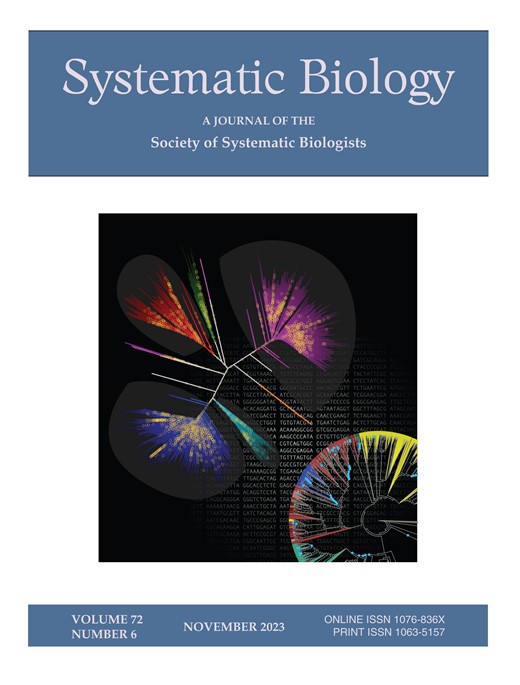测试多种区域特征与物种形成、灭绝和扩散的生物地理过程之间的关系
IF 5.7
1区 生物学
Q1 EVOLUTIONARY BIOLOGY
引用次数: 0
摘要
支系演化区域的空间和环境特征预计会影响生物地理过程,如物种分化、灭绝和扩散。任何区域特征(如海拔、距离、面积等)都可能与这些过程直接或间接相关。例如,距离、海拔或两者的差异可能会限制物种的扩散速度。然而,很难区分哪些特征与不同过程的速率关系最大。在此,我们提出了一种可扩展的多特征地貌信息 GeoSSE(MultiFIG)模型,可同时研究任意数量的区域特征。MultiFIG 提供了一个概念框架,用于纳入大量不同类型的特征,包括分类特征、定量特征、区域内特征和区域间特征,以及一个数学框架,用于将这些特征转化为生物地理率,以进行统计假设检验。利用传统的贝叶斯参数估计和可逆跳跃马尔科夫链蒙特卡罗,MultiFIG 可以探索具有不同数量和组合的特征效应参数的模型,并对每个区域特征与核心过程之间的关系强度进行估计。我们通过模拟研究验证了这一模型,模拟研究涵盖了一系列具有不同区域数量、树大小和特征值的方案。我们还通过对南美洲蜥蜴属 Liolaemus 的实证案例研究来证明 MultiFIG 的应用,研究了与面积、距离和海拔相关的 16 个区域特征。我们的结果显示了两个重要的特征-过程关系:负的距离/分散关系和负的面积/灭绝关系。有趣的是,虽然发现安第斯山脉地区的物种变异率高于非安第斯山脉地区,但模型并没有赋予安第斯山脉或海拔相关参数显著性。这些结果凸显了在生物地理假设检验中考虑多种区域特征的必要性。本文章由计算机程序翻译,如有差异,请以英文原文为准。
Testing relationships between multiple regional features and biogeographic processes of speciation, extinction, and dispersal
The spatial and environmental features of regions where clades are evolving are expected to impact biogeographic processes such as speciation, extinction, and dispersal. Any number of regional features (such as elevation, distance, area, etc.) may be directly or indirectly related to these processes. For example, it may be that distances or differences in elevation or both may limit dispersal rates. However, it is difficult to disentangle which features are most strongly related to rates of different processes. Here, we present an extensible Multi-feature Feature-Informed GeoSSE (MultiFIG) model that allows for the simultaneous investigation of any number of regional features. MultiFIG provides a conceptual framework for incorporating large numbers of features of different types, including categorical, quantitative, within-region, and between-region features, along with a mathematical framework for translating those features into biogeographic rates for statistical hypothesis testing. Using traditional Bayesian parameter estimation and reversible-jump Markov chain Monte Carlo, MultiFIG allows for the exploration of models with different numbers and combinations of feature-effect parameters, and generates estimates for the strengths of relationships between each regional feature and core process. We validate this model with a simulation study covering a range of scenarios with different numbers of regions, tree sizes, and feature values. We also demonstrate the application of MultiFIG with an empirical case study of the South American lizard genus Liolaemus, investigating sixteen regional features related to area, distance, and elevation. Our results show two important feature-process relationships: a negative distance/dispersal relationship, and a negative area/extinction relationship. Interestingly, although speciation rates were found to be higher in Andean versus non-Andean regions, the model did not assign significance to Andean- or elevation-related parameters. These results highlight the need to consider multiple regional features in biogeographic hypothesis testing.
求助全文
通过发布文献求助,成功后即可免费获取论文全文。
去求助
来源期刊

Systematic Biology
生物-进化生物学
CiteScore
13.00
自引率
7.70%
发文量
70
审稿时长
6-12 weeks
期刊介绍:
Systematic Biology is the bimonthly journal of the Society of Systematic Biologists. Papers for the journal are original contributions to the theory, principles, and methods of systematics as well as phylogeny, evolution, morphology, biogeography, paleontology, genetics, and the classification of all living things. A Points of View section offers a forum for discussion, while book reviews and announcements of general interest are also featured.
 求助内容:
求助内容: 应助结果提醒方式:
应助结果提醒方式:


